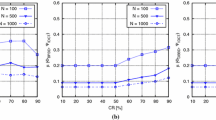Abstract
In this paper, we consider a point-to-point wireless communications for embedded battery powered systems. We aim to provide an optimal use of all the usable capacity inside the battery before it becomes exhausted. For this purpose, we exploit the recovery effect to extend their lifetime. We consider a stochastic battery model and use both dynamic programming and reinforcement learning approaches to compute optimal transmission policies for wireless sensor networks. The obtained results show that the expected total transmitted data and the battery lifetime are maximized when all the charge units inside the battery are consumed.












Similar content being viewed by others
References
Atzori, L., Iera, A., & Morabito, G. (2010). The internet of things: A survey. Computer Networks, 54(15), 2787–2805.
Goldsmith, A. (2005). Wireless communications (1st ed.). Cambridge: Cambridge University Press.
Estrin, D., Girod, L., Pottie, G., & Srivastava, M. (2001). Instrumenting the world with wireless sensor networks. In Proceedings of IEEE international conference on acoustics, speech and signal processing (ICASSP 2001), Salt Lake City, Utah, USA (Vol. 4, pp. 2033–2036).
Bennis, I., Zytoune, O., Aboutajdine, D., & Fouchal, H. (2013). Low energy geographical routing protocol for wireless multimedia sensor networks. In 9th international wireless communications and mobile computing conference (IWCMC), 2013. IEEE (pp. 585–589).
Dbibih, I., Zytoune, O., & Aboutajdine, D. (2014). On/off markov model based energy-delay aware mac protocol for wireless sensor network. Wireless Personal Communications, 78(2), 1143–1155.
Zytoune, O., & Aboutajdine, D. (2016). Energy usage analysis of digital modulations in wireless sensor networks with realistic battery model. Wireless Networks, 22(8), 2713–2725.
Sharma, M. K., & Murthy, C. R. (2017). On the design of dual energy harvesting communication links with retransmission. IEEE Transactions on Wireless Communications, 16, 4079–4093.
Vullers, R. J., Van Schaijk, R., Visser, H. J., Penders, J., & Van Hoof, C. (2010). Energy harvesting for autonomous wireless sensor networks. IEEE Solid-State Circuits Magazine, 2(2), 29–38.
Assaouy, M., Zytoune, O., & Aboutajdine, D. (2017). DP and RL approach optimization for embedded system communications with energy harvesting, I4CS 2017, CCIS 717 (pp. 167–182).
Sutton, R. S., & Barto, A. G. (1998). Reinforcement learning: An introduction. Cambridge, MA: MIT Press.
Kaelbling, L. Pack, Littman, M. L., & Moore, A. W. (1996). Reinforcement learning: A survey. Journal of Artificial Intelligence Research, 4, 237–285.
Chiasserini, C. F., & Rao, R. R. (1999). Pulsed battery discharge in communication devices. In Proceedings MobiCom, Seattle, WA.
Chau, C.-K., Qin, F., Sayed, S., Wahab, M. H., & Yang, Y. (2010). Harnessing battery recovery effect in wireless sensor networks: Experiments and analysis. IEEE Journal on Selected Areas in Communications, 28(7), 1222–1232.
He, L., Meng, G., Gu, Y., Liu, C., Sun, J., Zhu, T., et al. (2017). Battery-aware mobile data service. IEEE Transactions on Mobile Computing, 16, 1544–1558.
Chiasserini, C. F., & Rao, R. R. (2001). Improving battery performance by using traffic shaping techniques. IEEE Journal on Selected Areas in Communications, 19(7), 1385–1394.
Jongerden, M. R., & Haverkort, B. R. (2009). Which battery model to use? IET Software, 3(6), 445–457.
Chiasserini, C. F., & Rao, R. R. (1999). A model for battery pulsed discharge with recovery effect. In Wireless communications and networking conference (pp. 636–639).
Papoulis, A. (1965). Probability, random variables, and stochastic processes. New York.
Mansour, Y., & Singh, S. (1999). On the complexity of policy iteration. In Proceedings of the 15th international conference on uncertainty in AI, Stockholm, SE (pp. 401–408).
IEEE 802.15.4e Draft Standard: Wireless Medium Access Control (MAC) and Physical Layer (PHY) Specifications for Low-Rate Wireless Personal Area Networks (WPANs), IEEE Standards, March 2010.
Galindo-Serrano, A., Giupponi, L., & Dohler, M. (2010). Cognition and docition in OFDMA-based femtocell networks. In IEEE Globecomm, Miami, Florida, USA (pp. 6–10).
Author information
Authors and Affiliations
Corresponding author
Additional information
Publisher's Note
Springer Nature remains neutral with regard to jurisdictional claims in published maps and institutional affiliations.
Rights and permissions
About this article
Cite this article
Assaouy, M., Zytoune, O. & Ouadou, M. Battery Recovery-Aware Optimization for Embedded System Communications. Wireless Pers Commun 110, 1929–1946 (2020). https://doi.org/10.1007/s11277-019-06820-1
Published:
Issue Date:
DOI: https://doi.org/10.1007/s11277-019-06820-1




